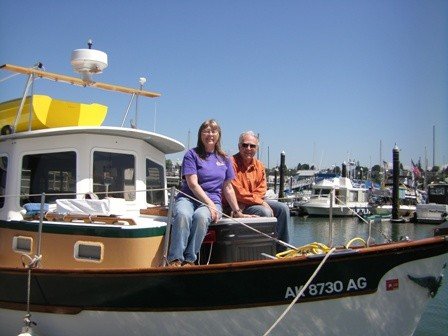FF
Guru
- Joined
- Oct 12, 2007
- Messages
- 22,552
The Nylon folks will simply go with 3-1 scope and about 20 ft of chain on the anchor
PLUS!! a rode rider on a seperate line , usually a similar weight to the anchor , but light enough to hand over to recover.
Yes , that's 3 lines in the water , anchor trip buoy , anchor and rode rider . But they seldom get snarled .
Big advantage is the ride is soft /quiet and there in no need to carefully wash/ scrub hundreds of ft of stinking bottom mud off the chain.
The windlass or capstan is ONLY to drag the ground tackle up from the sea floor esp with chain..
The boats engine gets the boat over , and breaks out the anchor.
On deck the break out loads are taken by a chain stopper , as are the usual anchor loads.
THIS -deck chain stopper- is the strong point , not the windlass.
Light nylon 1/4 or 3/8 20ft or more snubbers should tie to bow hawse holes , not over the bow roller . The "best " is to have the snubbers spliced and shakeled to a waterline fitting .
So anchoring say 100ft is let out in 40 ft of water, a SS sail boat snap shakel is snapped to the chain (15 ft long ) and another 20 ft of chain is veered.
Most of the time the light snubber will give a smooth ride , when the chain starts to pull on the deck stopper it gets noisy , and the boat will jerk.
Thats either time to pull in and replace the thin line with thicker , , or veer more chain and reinstall the snubber.
All this is far simpler with nylon , but not in coral.
FF
PLUS!! a rode rider on a seperate line , usually a similar weight to the anchor , but light enough to hand over to recover.
Yes , that's 3 lines in the water , anchor trip buoy , anchor and rode rider . But they seldom get snarled .
Big advantage is the ride is soft /quiet and there in no need to carefully wash/ scrub hundreds of ft of stinking bottom mud off the chain.
The windlass or capstan is ONLY to drag the ground tackle up from the sea floor esp with chain..
The boats engine gets the boat over , and breaks out the anchor.
On deck the break out loads are taken by a chain stopper , as are the usual anchor loads.
THIS -deck chain stopper- is the strong point , not the windlass.
Light nylon 1/4 or 3/8 20ft or more snubbers should tie to bow hawse holes , not over the bow roller . The "best " is to have the snubbers spliced and shakeled to a waterline fitting .
So anchoring say 100ft is let out in 40 ft of water, a SS sail boat snap shakel is snapped to the chain (15 ft long ) and another 20 ft of chain is veered.
Most of the time the light snubber will give a smooth ride , when the chain starts to pull on the deck stopper it gets noisy , and the boat will jerk.
Thats either time to pull in and replace the thin line with thicker , , or veer more chain and reinstall the snubber.
All this is far simpler with nylon , but not in coral.
FF

